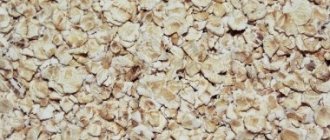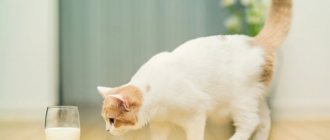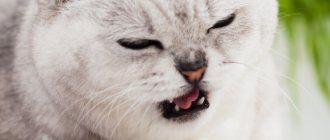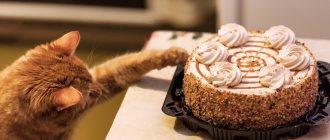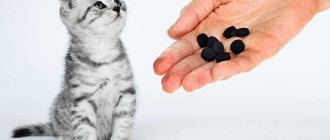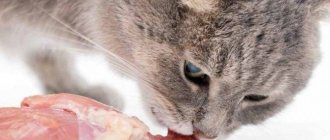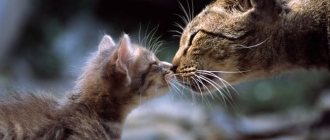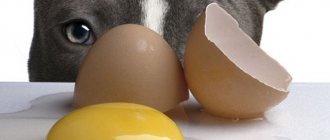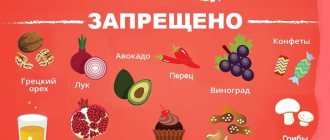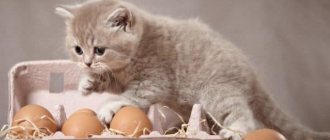An unbalanced diet contributes to the development of various diseases in domestic cats. For a long and happy life, a cat needs healthy foods and, as a result, the mandatory inclusion of different types of cereals in the diet. In the article we will look at the beneficial properties of porridge for the body of cats, what types are acceptable and prohibited in a cat’s diet, and whether it is possible to give cats regular buckwheat. We will also study the question of how often it can be introduced into the diet, at what age and how to prepare porridge.
Natural food is very beneficial for cats
Cereals for cats: benefits and harms
There are many opinions on whether porridge is good for cats or not. They can be divided into three options.
First. Cats, cats and kittens can not only eat porridge, but also need it. Most veterinarians, by the way, also think so. The explanations are simple: the stomachs of mice and birds that cats eat contain grains. This means that porridge is a must in the diet as a source of microelements, vitamins and fiber. Moreover, in such a theory it is always specified which porridge can be fed to a cat and which cannot. There is no general opinion, however. Some people allow buckwheat, rice and oatmeal. Some people are categorically against rice, but leave buckwheat, oatmeal and barley in their diet. And so on.
Second. According to another version of the opinion, cereals do more harm than good. But they are acceptable if the cat does not have obvious negative reactions to such food. There are also veterinarians here who agree with this point of view. They stipulate that cats should not eat porridge every day. It is desirable that its share be up to 25% of the diet, or better yet, 5-10%.
To eat or not to eat, that is the question
Third. The third point of view is expressed in the word “no”. It is strictly forbidden to feed a cat, cat or kitten porridge. It is believed that in the natural environment cats do not eat porridge, and the grains that fall into the cat along with the stomach of the prey are too small, and moreover, they are already processed by the victim’s body. Your cat can get fiber from vegetables. And even that is needed only in an amount of no more than 5-10% of the diet. The cat will not absorb vitamins and microelements from cereals, because... She can get everything her body needs from animal products, because a cat is a predator.
Acceptable grains for cats' diets
We have come to cereals that can be called acceptable. In order not to mislead you, we will outline some points from the physiology of cats. A healthy cat that receives adequate nutrition does not need cereal a priori. The animal’s body synthesizes a small amount of slow carbohydrates, which are enough to nourish the brain. Otherwise, the cat’s body only needs proteins, fats, amino acids, vitamins and microelements. The cat receives a small amount of carbohydrates by consuming coarse fiber - grass, the contents of the stomach and intestines of game, vegetables, roots, insects.
Oatmeal, flakes and Hercules can be recommended for inclusion in the diet of kittens, older animals and very active cats. Oatmeal has a positive effect on intestinal function and has a calming and enveloping effect. Unlike most cereals, oatmeal is quite easy to digest and is not contraindicated for cats with a sensitive digestive system. In addition to carbohydrates, porridge contains B vitamins, vitamin E and H
Please note that vitamin H is considered deficient as it is only found in small amounts and in some foods
Phytic acid, which this cereal is rich in, accumulates in the body. At a certain concentration, the acid reacts with vitamins, binds them and removes them from the body. In addition, oatmeal contains a significant amount of gluten.
If your cat has been recommended a diet with oatmeal, it is better to choose flakes rather than cereal; many people know them by the name oatmeal porridge. Flakes are crushed, steamed grains. When cooked, the flakes release a little mucus, which is good for the intestines.
Buckwheat and rice cereals are two products for which there are no categorical prohibitions. It is useless to compare these cereals; they are mutually unique and useful in their own way. Buckwheat is a rich source of vitamins and microelements. In addition, this porridge is a leader in protein content, saturation and overall benefits. Rice is neutral and suitable for feeding allergy sufferers, which is a big plus. Rice porridge is also one of the available gluten-free products.
Why do cats love porridge?
Not all cats love cereal. Oatmeal, for example, does not arouse interest in animals. To force the cat to eat such a breakfast, the owner cheats and flavors the cereal with milk.
Ordinary boiled porridge with water is unlikely to interest a cat. But if you add pieces of tasty meat or fish fillet to it, the cat will gladly swallow the entire portion and even ask for more. Cats love porridge with the smell of meat. Therefore, cereals are cooked in low-fat meat broth without spices and salt. The finished product should have a liquid consistency.
Cats love porridge with meat additives
Porridge can be fed to cats up to twice a week. This is quite enough to saturate the body with essential microelements and vitamins.
You need to accustom your cat to such dishes from an early age. Kittens can be given porridge with milk, adults can be diluted with fermented milk products without additives. To improve the taste, you can add a little vegetable oil to dairy-free porridge.
What cereals are good for cats?
So, we found out which cereals are harmful for cats, but these cereals are in great demand in the diet of animals:
- Buckwheat porridge can give you a lot of good things: strong immunity, healthy skin and coat, normalization of the digestive system and blood circulation, stomach and pancreas. It contains many vitamins B, E, PP, iron, calcium, phosphorus, copper, iodine and cobalt. In addition, buckwheat is very nutritious due to its high protein content;
- Rice porridge for cats is considered a source of vitamins B, PP and E and contains selenium, potassium, iodine, iron, calcium, and zinc. Animals that regularly consume rice have a strong heart and nervous system, strong immunity, beautiful coat and healthy skin. In addition, rice helps normalize stool. Rice is also suitable for cats prone to allergies as it is gluten-free. Uncooked rice porridge cooked in meat broth is usually preferred by cats. Buckwheat and rice are perhaps the most suitable cereals for cats. What about oatmeal and barley porridge? Oatmeal and barley porridges are good for cats, but they are contraindicated.
- Hercules is a healthy cereal because of its antioxidants, and it is wise to give it to cats suffering from bacterial and viral infections. Hercules contains vitamins B, PP, E, iron, calcium, magnesium and phosphorus. This product strengthens the animal's bones and prevents the development of anemia. As a rule, liquid porridge is well absorbed by the cat’s body, normalizes stool during diarrhea and soothes abdominal pain. However, you should not feed your cat too often due to the gluten content in oats, which can negatively affect their health;
- Pearl barley porridge is a pearl in the line of porridges; it is rich in vitamins A, B, D, E, PP, selenium, potassium, calcium, iron, copper, manganese, molybdenum, strontium. It can also be given to cats, but not more than 1-2 times a week. Pearl porridge (pearl and barley) in the diet makes life easier for cats with stomach problems; it is also good for bones and vision, the nervous system and the cat’s coat. But barley and barley should be given with caution to animals suffering from chronic constipation.
Acceptable cereals for cats
Next, we will consider what types of cereals can be given to cats. Experienced veterinarians advise adding the following cereals to the animal’s diet:
- Rice porrige. Better from unpolished cereals. It contains a large number of useful microelements. Rice has a beneficial effect on the digestion process and promotes good stool. You can cook rice in low-fat broth, without adding salt and spices.
- Buckwheat porridge. This porridge is also very useful in your pet’s diet. Buckwheat contains a lot of fiber, calcium, proteins, and carbohydrates. Porridge is a source of strength and vigor. Calcium is good for bones, especially important for small kittens. Buckwheat porridge can also be cooked in broth, adding pieces of meat, fish, and vegetable oil.
Not all cat cereals are equally healthy
- Oatmeal. Biotin, magnesium, phosphorus, calcium, zinc, sodium, potassium - this is not the whole list of useful things that oatmeal contains. It can be cooked in milk without adding sugar and salt.
- Pearl barley porridge. It contains beneficial amino acids that improve intestinal function and prevent the development of allergic reactions in the animal. Such cereals can be boiled in meat broth and served with pieces of boiled meat.
Allowed types of cereals
You cannot feed your domestic cat all types of grains; only four of them are allowed.
Oatmeal
Oat grains contain:
- up to 15% carbohydrates;
- macro- and microelements potassium, calcium, magnesium, phosphorus, iron, zinc;
- vitamins A, E, H, PP, almost all B vitamins;
- antioxidants that increase the body's resistance.
Oatmeal is well digestible, has an enveloping and anti-inflammatory effect, and has a positive effect on the gastrointestinal tract, so it is recommended to include it in the diet of cats with sensitive digestion, kittens and elderly animals.
Rice
Rice is a natural absorbent; it perfectly cleanses the intestines and stabilizes the digestion process. More than half of the composition of this cereal is carbohydrates; it also contains 10 types of macro- and microelements, vitamin C and 5 representatives of B vitamins.
To prepare cat food, it is better to use unpolished rice (it retains more nutrients). You can add fish, meat, and boiled vegetables to the rice porridge prepared for your cat.
Buckwheat
Like other cereals, buckwheat contains a large amount of carbohydrates. It also contains 6 types of B vitamins, vitamins A, C, D, E, H, K, PP. The list of mineral elements contained in buckwheat grains is presented in a list of 19 items. Buckwheat porridge for a cat can be cooked in water or broth, seasoned with vegetable oil or animal fat, and finely chopped meat added to it.
Pearl barley (barley)
Barley grain contains a standard set of vitamins and minerals for cereals. The calorie content of porridges made from barley cereals is low, and they take a long time to digest and clean the gastrointestinal tract well, so they are useful for overweight cats. It is better to cook pearl barley or barley porridge together with pieces of meat or fish. To speed up cooking, it is recommended to soak the cereal for several hours before cooking.
What cereals are prohibited
Semolina porridge is absolutely useless for cats. It has no beneficial properties and only quickly saturates the body with empty carbohydrates, which can be completely unsafe for the cat’s body.
Semolina can be given to cats as an exception, infrequently and in small quantities. Because if you feed your furry pet such useless food, there is a high probability of developing urolithiasis and diabetes in the animal. There are also greater risks of obesity.
Corn porridge is also included in the category of prohibited products. It is very poorly digestible and can cause serious health problems, especially if the animal already suffers from diseases of the digestive tract.
It is also better not to include pea porridge on the menu. This product is not absorbed by the animal's body and causes constipation and flatulence.
And millet porridge is not recommended for feeding cats and kittens. Such cereals are difficult to digest and lead to bloating, flatulence, intestinal colic and dysbacteriosis. It contains a lot of gluten and gluten, and this is harmful to the body of cats.
We remember forbidden cereals and never give them to cats
The list of prohibited cereals also includes barley porridge, which is poorly digestible and negatively affects the functioning of the gastrointestinal tract of animals. Once in a cat's body, the product causes severe fermentation, flatulence, bloating, spasmodic pain and constipation.
Regular consumption of barley porridge leads to the development of inflammatory processes in the intestines and other gastrointestinal diseases.
Is it possible to give rice to a cat?
Having decided to feed your cat homemade natural food, you need to clearly understand all the responsibility that falls on the owner’s shoulders for the cat’s health. Many people immediately wonder if cats can have rice, buckwheat and other grains. Which meat is best and in what form to eat vegetables.
In ready-made food, everything is simple, you buy it, feed it, and the manufacturer takes care of the composition. But there are also some nuances, the first of which is price. But many simply believe that homemade food for a cat will be healthier and it is difficult to convince them of this, and is it necessary to do this?
Which cereals are suitable for sterilized and neutered animals?
One of the questions for the owner is whether it is possible, and if so, what kind of porridge to cook for castrated and sterilized cats. Rice, corn, wheat and oatmeal are best suited for them. But semolina porridge is too high in calories for sedentary animals, who are already prone to gaining excess weight after surgery. It may also be that the cat refuses to eat the porridge; here again a trick will come to the rescue: add a little lean meat when cooking.
Porridge can cause weight gain in cats after surgery
The value of cereals for animal health
- If it has been decided to feed the pet natural food, then the basic diet must be supplied with various cereals. In particular, we are talking about rice, which concentrates many valuable substances. The basis is phosphorus with magnesium, and rice grains are not devoid of zinc, calcium, potassium, silicon, B-group vitamins and other useful substances.
- However, despite all the usefulness, it is prohibited to treat your four-legged friend with large portions of the presented product. Rice strengthens, this property can be useful for diarrhea, but it will certainly harm if the cat has normal stool. Excessive intake of such porridge into the body will lead to hardening of stool and, as a result, constipation.
- Representatives of the cat family need to ensure the intake of carbohydrates into the body. Rice does the job perfectly. In this case, the animal will always be full of energy. Carbohydrates also ensure the absorption of other valuable substances obtained from food. In addition to rice, you should give your furry friend buckwheat, oatmeal, wheat and corn porridge.
Age at which kittens are allowed to eat porridge
Kittens begin to introduce porridge into their diet after one month of age. Do this gradually and in small portions. Porridges that can be given to kittens can be the same as those for adult cats, only up to the age of one year they are boiled in milk. When the cat becomes an adult, he switches to normal food (then the porridge is boiled in water or broth).
It is also recommended to give milk porridge to pregnant cats to saturate the body with calcium, which is very important for future offspring.
After the age of one month, the kitten can try porridge
Cooking principles
How to cook rice for a cat at home? Cats should be given exclusively boiled cereals as food. A great idea if you mix it with chicken pieces or fresh vegetables. The share of grain in such a dish should not exceed 25%. If you plan to give your pet exclusively this cereal, then a single serving is approximately 1/4 cup.
Let us remember, dear readers: only cooked cereal and nothing more - no sauce, no garlic gravy. Salt, onions, garlic, spices are all toxic to cats. At a minimum, oxidative damage to blood cells should be expected when these products enter a delicate cat's body. Among other things, garlic causes gastroenteritis, accompanied by increased salivation, nausea, vomiting, diarrhea, and severe stomach pain.
A raw product is harmful to a cat, and absolutely unattractive to it. But there are exceptions, and sometimes it ends up in cat’s stomachs in its raw form. The reaction is not long in coming: bloating, severe vomiting and diarrhea. Alarming symptoms persist for 24 hours, which means immediately contact a veterinarian for treatment.
Frequency of feeding the animal with cereals
Cereals and grains should appear in a cat’s diet no more than once every 2 days. Veterinarians recommend mixing cereals with meat in a ratio of 1 to 3. It is worth reducing the proportion if your cat refuses grains. Because most cats don’t eat porridge without any meat or fish.
For an adult animal, porridge should not be cooked with milk, because it can be harmful due to diarrhea, increased gas formation, or lactose intolerance.
Don't get carried away with your daily breakfast of cereals
It is worth paying attention to instant porridges. Such products are harmful and contraindicated for cats. They contain a lot of harmful preservatives, salt, soy and sugar; they contain only a minimum of useful fiber and vitamins.
Is it possible to give rice to kittens?
Today, leading manufacturers of products for four-legged pets supply various food for cats to the shelves of pet stores. However, for unknown reasons, some owners continue to feed the animal what is called homemade food. It is important to understand that all responsibility for the cat’s health falls solely on your shoulders. If you create an incorrect diet, your pet will develop serious problems with the liver and gastrointestinal tract. In today's material we will study the possibility or impossibility of treating a cat with rice.
Norms of porridge in the diet
Cats are predators by nature. Therefore, the basis of the diet is undoubtedly meat. But cereals are also important for the body. If you calculate the percentage of porridge in a cat’s diet, then it should be no more than 20%. By giving more than this amount, you can doom your pet to suffer from disruption of the intestinal microflora, as well as the acquisition of health problems: allergic reactions, obesity, decreased immunity, diseases of internal organs.
Meat is the basis of the diet, cereals are a supplement
Thus, when creating your pet’s menu, you need to pay attention to the balance of meat (you can’t feed it alone, as this leads to constipation and bloating) and cereals.
Therefore, when planning your cat’s diet, do not forget to include several healthy cereals. This can be buckwheat, rice and oatmeal, which not only promote good digestion, but also bring many useful vitamins and microelements to the animal’s body.
Feeding rules
Cats are carnivorous animals, so their diet should contain no more than 20% cereal. Optimal feeding regimen: porridge 3 times a week.
This product should not be given to pets very often, as it can provoke a disturbance in the intestinal microflora. As a result, your pet may develop diseases of internal organs, decreased immunity, excess weight and allergic reactions. It is especially important to monitor the diet of spayed and neutered pets.
Porridge should be prepared immediately before feeding. It is given warm and in small portions. If the pet does not eat the portion, the leftovers must be thrown away. Otherwise, they will deteriorate and may cause illness.
You need to carefully introduce porridge into your cat’s diet, as there is a whole list of cereals that can cause harm to the animal. Therefore, you can give your pet only the four types of grain crops described above.
Our readers' pets
Become authors, share photos of your pets Send a photo
This is interesting: Can kittens have kefir?
How to cook delicious porridge for cats
A delicious recipe for rice porridge for cats is as follows. For cooking you will need ingredients:
- 2 cups unparboiled rice
- 0.5 cups sprouted grains (any)
- 1 tbsp olive oil
- 1 cup minced meat, preferably chicken or turkey
- 2 tbsp vegetable oil
- green onions, finely chopped if desired
- water
To prepare porridge, take a small saucepan, fill it with water and boil it. When the water boils, pour the rice into the pan and reduce the heat. The water should boil again. After this, leave the heat at minimum power and cook the rice for 30 minutes. We leave the lid closed, but the rice must be stirred occasionally to prevent it from burning.
While the rice is cooking, lightly fry the remaining ingredients. Place the pan on medium heat. Add vegetable oil, green onions and sprouted cereal to it. Fry for 2-3 minutes. Then add olive oil and meat. Let's simmer everything together. After this, pour the contents of the frying pan into the pan with rice, mix thoroughly and cook for another 10 minutes. Next, let the porridge brew with the lid closed. Once the porridge has cooled, it can be given to the cat.
Hot porridge breakfast, isolated on a white background
Hercules porridge for cats can be prepared with liver.
Take the liver (you can take any that your cat likes), 2-3 glasses of water and a glass of oatmeal.
Boil water in a saucepan. Cut the liver into small pieces and pour into boiling water. Next we add Hercules. Mix everything thoroughly and wait for the porridge to boil. After this, close the pan with a lid and turn the heat to minimum. Stir the porridge periodically. Cooking time depends on the type of flakes and the size of the liver. Usually it is 2-3 times more than when cooking just flakes. There is no need to add salt or sugar. The finished porridge can be put in the refrigerator; the shelf life of the porridge should not exceed a week.
The animal is fed warm porridge. Once removed from the refrigerator, you can heat it in the microwave. If the porridge is thick, you can heat it up by adding boiling water. You can add dry milk to the finished porridge, mixing thoroughly.
Pearl barley porridge for cats is good served with grated carrots and turkey breast.
Cook pearl barley (2 cups) as usual, only without salt. The cooking process can be speeded up by soaking the grains a day before. Cut the turkey into small cubes, put it in a bag and put it in the freezer. To prevent the pieces from sticking to each other, the bag must be shaken periodically. Take a small carrot, peel it and grate it.
Now take 4 tbsp. porridge, 1 tsp. grated carrots, 2 tbsp. turkey, scalded with boiling water, and mix together. To soften the porridge, add 1 tbsp. boiling water Mix thoroughly and give to the cat. The proportions of pearl barley porridge can be changed at your pet’s discretion.
Rice water for cats
Many owners do not consider diarrhea a dangerous symptom. But in vain. After all, it can indicate dangerous diseases, and diarrhea itself in small kittens can lead to serious dehydration in just a day. To protect your pet, it is necessary to promptly determine the cause of diarrhea.
Bacterial infection. It has a very high temperature. In this case, diarrhea has an unpleasant odor, the stool is liquid or even becomes watery, and often turns green. The pet feels unwell, refuses to eat, and is apathetic.
Viral infection. Such severe inflammation does not develop as with microbial infection. The temperature is also increased, but not so much. Although the pet is less mobile, it is active and does not refuse food. Feces are often yellow and mushy.
Worms. The kitten is quickly losing weight, feels unwell, the tummy is swollen and tense, and when palpated, lumps may be detected. There is a lot of mucus in stool, which is why it becomes gray in color and has a strong unpleasant odor. Often there is blood in the stool or it turns black. Sometimes the animal vomits, the vomit can be in the form of white foam, sometimes it contains live worms.
Allergy to food. In an allergic reaction, diarrhea occurs immediately after eating. An important distinguishing feature is a new product in the diet. Allergy stool is yellow and mushy. At the same time, other signs of allergies appear: dermatitis, hair loss, swelling, spot redness.
Food poisoning. It occurs among careless owners who do not know what to feed the kitten. When giving spoiled or unsuitable food to kittens, diarrhea is observed immediately after feeding, 2-3 hours later.
The stool is mushy, yellow, defecation is observed 2-3 times in a row, but after cleansing the intestines everything stops.
In case of serious poisoning, diarrhea does not stop on its own, the animal feels unwell, and may even vomit.
Stress. When buying a kitten, the new owner must understand that the pet is changing its place of residence and parting with its mother. All this is a powerful stress for the kitten. Therefore, diarrhea is a common occurrence. The difference between psychological diarrhea is the behavior of the pet. He often meows, calls his mother, hides in dark corners, and can behave aggressively.
Feeding disorder. Improper feeding may include a diet unbalanced in vitamins, proteins and microelements, violation of the feeding regime, overfeeding or underfeeding, and a rapid transition to adult food. The feces are yellow and mushy, the kitten feels well, plays, and has a healthy appetite.
Diet therapy for a kitten
If you suspect a food allergy, poisoning or diarrhea due to improper feeding, diet therapy should be carried out.
The goal of the fasting diet is to empty the intestines. Please note that if you have diarrhea due to improper feeding, this is not necessary. But in case of nutritional allergies or poisoning, this is just relevant.
Fasting diet rules:
- It is kept strictly for 10-12 hours, that is, you need to start it in the morning, and finish it in the evening and feed the kitten. A hunger strike cannot be maintained longer, since a young body needs frequent feeding and reacts sharply to a lack of food.
- If you are on a hunger strike, you can relieve your kitten's situation by feeding him rice water. The rice is boiled, after which the rice itself is not given to the pet, but is fed with liquid. Rice water has an astringent and strengthening effect, and also contains some nutrients.
- Water should be available to the kitten. Of course, it must be clean.
- Try not to eat in front of the kitten so as not to irritate it.
If you have allergies, you need to switch to natural nutrition.
What may be on the menu:
- Boiled lean meat (beef, chicken, goat);
- Boiled fish;
- Hard-boiled eggs;
- Baby food (make sure the ingredients are natural);
- Porridge on the water.
What not to feed:
- Fatty foods;
- Pork, other fatty meats and fish;
- Spicy or salty foods;
- Fried foods;
- Milk from the store, but milk from a mother cat will be beneficial, on the contrary. Of course, this rule does not work for a one-month-old kitten that feeds only on milk.
The diet differs depending on the age of the animal:
- A one-month-old kitten is fed exclusively with milk until it is 2-3 weeks old. At the same time, it is advisable to buy natural products for newborns at baby food points, rather than using milk from the store.
- Kittens at 2 months need both milk and complementary foods. The most suitable complementary foods are porridge with water, cottage cheese, and boiled eggs. Meat can be given in small quantities, but it is better to avoid fish.
- A pet at 3 months is fed adult food. Increase the amount of meat and meat products; the ratio of meat to porridge should be 1:1. Boiled vegetables are also added to the diet.
- A kitten at 4 months can already be fed fish; many people add meat and bone meal to the menu. During this period, the basis of the diet is porridge and meat.
- Water should be available to the kitten. Of course, it must be clean.
What medications should I give?
The rate of restoration of normal stool increases with an integrated approach to treatment.
To protect the intestinal walls, you can give the kitten strengthening decoctions:
- A decoction of chamomile, St. John's wort or other plants. They are usually sold in pharmacies as a complex set of various herbs.
- A decoction of oak bark has the strongest astringent effect.
They are brewed like this:
- Pour 1-2 tablespoons of herbs into a glass.
- Pour boiling water over it.
- Let it brew for 30-40 minutes.
- Strain the broth.
To eliminate toxins, which is very important for allergies and poisoning, absorbents are used:
- Activated carbon – tablet or half.
- Enterosgel – ½ teaspoon.
For viral infections, antiviral drugs are used:
- Fosprenil.
- Ribotan.
- Camedon.
As always happens in life, in addition to its advantages, rice also has disadvantages. Cats are obligate carnivores; their main food product is meat. Rice does not contain enough protein, and protein is the source of energy for all cat species. In fact, rice has no significant nutritional value for a cat's body. In addition, it can cause increased gas formation.
Like other human foods, rice is not recommended for feeding cats. High-quality feed eliminates the need to use any food additives, which is unlikely to be achieved when feeding homemade products.
Eating too much rice can lead to malnutrition, even if your cat eats a lot. Of course, this can seriously affect your pet's health.
The cat's body is not adapted to digest plant foods. Treat rice like filler. Having no nutritional value, in large quantities it can cause many digestive disorders. Moreover, if your friend is not used to eating rice, he may feel sick. A diet high in rice impairs the development of newborns or small kittens.
To summarize, we can conclude that rice causes many more problems than it provides benefits, among which, perhaps, is only the fight against diarrhea.
Brief conclusions
Now, knowing about the advantages and disadvantages of rice, we can answer the question of including it in a cat’s diet.
Cats can eat rice. Particularly curious and hungry people may even try to chew it raw, but, like other grains, it should be excluded from the diet of animals of all breeds and of any age. Cooked rice in small quantities can be added to the food if the cat is suffering from severe diarrhea.
The lack of nutritional value, the danger of flatulence and the lack of essential substances make rice an undesirable food for healthy animals.
To improve your pet's condition, it is better to use specially developed food and vitamin supplements. The same applies to the fight against diarrhea - it is better to replace boiled rice with medications prescribed by a doctor. They are safe, take into account nutritional requirements, and are better adapted to the characteristics of the cat’s body.
If your cat suffers from any type of digestive disorder, don't count on rice to solve the problem. Contact your veterinarian and use his or her professional advice.
There is always a chance that your cat has an undiagnosed disease. Feeding food that is not intended for the animal will not help improve health, and at worst, it can even be harmful.
- Cutaneous horn General description of the disease Cutaneous horn on the forehead or face (ICD 10 code - L57.0) -...
- Itching and odorless discharge Main causesBefore considering the factors that provoke the appearance of discharge that has a sour odor, it is necessary to immediately note...
- Discharge in women What kind of discharge between menstruation is considered normal? Female discharge normally consists of mucus from the cervical canal, dead...
Source: https://zdorov4ik.ru/risovyy-otvar-koshki/
Are porridges compatible with ready-made food?
If you feed your cat prepared food, then you should not give it other food, including porridge, in addition to it. Feed manufacturers strive to achieve the necessary balance in the animal’s nutrition. And, perhaps, additional components in your pet’s diet can lead to an overabundance of certain elements in the body, which is as undesirable as their deficiency.
It is advisable to choose one diet option: food from the store or natural food
Food for six-month-old animals
From four to six months, the kitten is actively growing and gaining weight. It is important that the kitten’s menu is rich in foods that help increase muscle mass.
Since the baby's jaws are fully formed, he can chew chicken or beef freely. The pieces can no longer be ground, but given whole. In addition to meat and offal, it is advisable to give the kitten low-fat fermented milk products, such as fermented baked milk or unsweetened yogurt. It is important to remember that food should not turn into fat deposits in the body.
From the age of six months, you can add lean, boneless sea fish to your diet.
Expert advice
- Don't feed your cat only cereal. Still, cereals are not the natural food of predators. You should always ensure that your cat does not receive more carbohydrates than necessary.
- When preparing porridge, make it a little liquid. This will make it easier for your pet’s gastrointestinal tract to absorb the product.
- Veterinarians advise using unpolished rice in the cat's menu - it contains more vitamins.
- When preparing porridge, do not use spices or salt under any circumstances. Any flavoring additives cause addiction in cats, and salt leads to the development of urolithiasis.
- If for some reason you switch your cat from dry or wet store-bought food to natural food, introduce porridge a little at a time; individual cereals can provoke an allergic reaction.
Stomach and intestines of a cat | All about cats
Vomiting, diarrhea, constipation, blood in the stool - all these are signs of diseases of the gastrointestinal tract.
A variety of reasons cause the occurrence of each of the symptoms separately or their various combinations. I will focus only on the most common cases, and will not try to describe all the numerous diseases of the abdominal organs. Vomiting can be regular or one-time, indicating a mild infection of the stomach (gastritis) or an accumulation of swallowed hair in it. However, if it is severe, repeated, or accompanied by other signs of illness, then this indicates some serious illness, such as feline infectious enteritis , tumors, or intestinal blockage.
Diarrhea can be mild, caused, for example, by the cat drinking too much milk or eating too much meat, or caused by mild inflammation of the intestines; and it can be severe and debilitating, as in some cases of feline infectious enteritis.
Constipation is a consequence of an aging cat or poor diet, or indicates some other problem with the passage of food through the intestines.
Blood in the stool usually occurs as a result of scratching the intestinal mucosa with fragments of greedily swallowed bones or is a side effect of acute food poisoning. It can also appear due to a lack of digestive enzymes in the cat’s intestines.
If any of these symptoms persist for more than a few hours or are accompanied by other obvious signs of illness and you think something serious is happening to your cat, contact your veterinarian right away. Symptoms may indicate some kind of disease in the cat's stomach and intestines . Remember that loss of water and salts due to diarrhea and vomiting can have serious consequences.
To prevent dehydration and weakness, spoon-feed your cat water (salted to your liking and with a little glucose) as often as possible. If the main symptom is vomiting, then give your cat only liquid food, not solid food. You can give half a teaspoon of Maalox or baby water for colic, but do not give her cognac or milk.
If an animal has diarrhea , in this case you also need to give it more liquids.
It is very good to introduce about one-third of a cup of strong, sweet coffee, cooled to body temperature, through the anus using a regular syringe. This must be done very slowly and carefully.
You can pour a teaspoon of a special mixture into your cat's mouth, but do not use kaolin or diarrhea mixture containing morphine.
If diarrhea is caused by gluttony, you can give the cat a strong and thick rice water to drink. Rice water coats the intestinal walls and relieves irritation. You can give water through a syringe without a needle, 3-5 ml several times a day. Read how to give the medicine correctly here.
At the first sign
of constipation , immediately try giving your cat 2-3 full teaspoons of vegetable oil.
A tiny enema is also very effective in this case. If constipation becomes a chronic problem, try adding porridge, wheat, rolled oats, and buckwheat to your food. Severe or persistent forms of constipation should be treated by a veterinarian. He examines the digestive tract using palpation, fluoroscopy - it is possible that with the use of barium, gastroscopy; can carry out a special operation.
One of the most serious viral diseases is feline infectious enteritis . It affects not only the intestines, but also the liver and white blood cells.
This disease has a wide variety of symptoms; it can lead to the death of a cat within a few hours. Diarrhea does not always happen.
The veterinarian cannot kill the feline enteritis virus, but he will use antibiotics to prevent secondary bacterial infection.
To help treat dehydration, you may need to inject a salt solution under your skin. Of course, the best way out is to try to prevent this terrible disease. Therefore, be sure to vaccinate your cat and keep it up to date.
It happens quite often that stomach and intestines become abnormal in old age. Especially if the cat has not eaten properly all its life.
I recommend reading:
Constipation in a cat - causes, symptoms, diagnosis
Constipation in a cat - treatment
Vomiting in a cat - causes
Vomiting in a cat - treatment
Diarrhea in a cat - symptoms, causes, diagnosis
____________________________________________________ _______________________________________________
Source: https://nashi-koshi.ru/zheludok-i-kishechnik-koshki/
What to do if the cat does not eat porridge?
It is easy to persuade your pet to eat porridge if you add pieces of meat. It should be boiled. You should choose lean varieties. When the pet refuses to eat such a dish, a little wet cat food or crushed dry food is added to it.
Be sure to read:
Comparison of cat food of different classes: what should be included, analysis of dry and wet food,
At first, the animal may not eat the prepared food completely, but, gradually getting used to it, it will eat fully. Feeding porridge should be regular.
When should cats not be given rice?
As always happens in life, in addition to its advantages, rice also has disadvantages. Cats are obligate carnivores; their main food product is meat. Rice does not contain enough protein, and protein is the source of energy for all cat species. In fact, rice has no significant nutritional value for a cat's body. In addition, it can cause increased gas formation.
Like other human foods, rice is not recommended for feeding cats. High-quality feed eliminates the need to use any food additives, which is unlikely to be achieved when feeding homemade products.
Eating too much rice can lead to malnutrition, even if your cat eats a lot. Of course, this can seriously affect your pet's health.
The cat's body is not adapted to digest plant foods. Treat rice like filler. Having no nutritional value, in large quantities it can cause many digestive disorders. Moreover, if your friend is not used to eating rice, he may feel sick. A diet high in rice impairs the development of newborns or small kittens.
To summarize, we can conclude that rice causes many more problems than it provides benefits, among which, perhaps, is only the fight against diarrhea.

